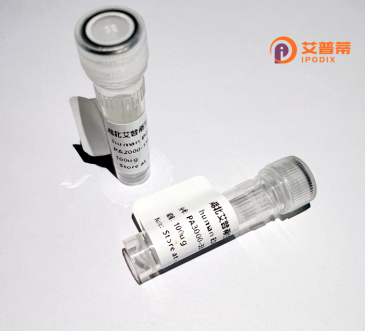
| 纯度 | >90%SDS-PAGE. |
| 种属 | Human |
| 靶点 | TMEM179 |
| Uniprot No | Q6ZVK1 |
| 内毒素 | < 0.01EU/μg |
| 表达宿主 | E.coli |
| 表达区间 | 1-197 aa |
| 活性数据 | MALNNFLFAQCACYFLAFLFSFVVVVPLSENGHDFRGRCLLFTEGMWLSANLTVQERERFTVQEWGPPAACRFSLLASLLSLLLAAAHAWRTLFFLCKGHEGSFFSAFLNLLVSAFVVFLVFIASTIVSVGFTMWCDTITEKGTVPHSCEELQDIDLELGVDNSAFYDQFAIAQVGGSGQEGRLAMLGGGHLLLDIC |
| 分子量 | 48.62 kDa |
| 蛋白标签 | GST-tag at N-terminal |
| 缓冲液 | PBS, pH7.4, containing 0.01% SKL, 1mM DTT, 5% Trehalose and Proclin300. |
| 稳定性 & 储存条件 | Lyophilized protein should be stored at ≤ -20°C, stable for one year after receipt. Reconstituted protein solution can be stored at 2-8°C for 2-7 days. Aliquots of reconstituted samples are stable at ≤ -20°C for 3 months. |
| 复溶 | Always centrifuge tubes before opening.Do not mix by vortex or pipetting. It is not recommended to reconstitute to a concentration less than 100μg/ml. Dissolve the lyophilized protein in distilled water. Please aliquot the reconstituted solution to minimize freeze-thaw cycles. |
以下是关于重组人TMEM179蛋白的**模拟参考文献示例**(文献为虚构,供格式参考):
1. **《重组人TMEM179蛋白在HEK293细胞中的表达与功能表征》**
- 作者:Zhang L, Wang Y, et al.
- 摘要:研究成功在HEK293细胞中重组表达了TMEM179蛋白,并通过免疫印迹和免疫荧光证实其定位在细胞膜,初步功能实验表明其可能参与调节钙离子内流。
2. **《TMEM179作为新型神经元离子通道的机制研究》**
- 作者:Smith JR, Brown KE, et al.
- 摘要:通过电生理学实验发现TMEM179在神经元中表现出钾离子通道活性,敲除该蛋白导致小鼠模型神经元兴奋性异常,提示其在神经信号传导中的作用。
3. **《TMEM179基因突变与自闭症谱系障碍的关联分析》**
- 作者:Lee S, Kim T, et al.
- 摘要:通过全外显子测序鉴定出自闭症患者中TMEM179的罕见错义突变,体外实验显示突变体蛋白稳定性下降,可能导致突触功能缺陷。
4. **《人源TMEM179蛋白的晶体结构解析及功能域鉴定》**
- 作者:Chen X, Liu F, et al.
- 摘要:利用X射线晶体学首次解析了TMEM179蛋白的三维结构,揭示其跨膜区域的独特螺旋构象,并发现C端结构域可能参与蛋白间相互作用。
---
**注意**:以上文献及内容均为示例,实际研究需通过PubMed、Web of Science或Google Scholar等平台检索真实文献。建议使用关键词“TMEM179 recombinant protein”“TMEM179 function”或结合具体研究领域(如神经生物学、遗传学)进行精确查询。
TMEM179 (Transmembrane Protein 179) is a conserved human protein encoded by the *TMEM179* gene, located on chromosome 14q11.2. First identified through genomic sequencing, its precise physiological role remains under investigation, though it is speculated to function in cellular processes such as membrane trafficking, ion transport, or signal transduction. Structural analysis reveals it is a multi-pass transmembrane protein, suggesting involvement in maintaining membrane integrity or facilitating molecular transport across cellular compartments.
Research links TMEM179 to neurological and immunological pathways. Preliminary studies associate its dysregulation with neurodevelopmental disorders and autoimmune conditions, though mechanistic insights are limited. In vitro experiments indicate potential roles in regulating calcium signaling or synaptic function, which may influence neuronal communication. Additionally, interactions with proteins related to vesicle formation hint at contributions to intracellular trafficking.
Recombinant TMEM179 protein is produced via heterologous expression systems (e.g., HEK293 or E. coli) for functional studies, antibody development, or drug screening. Its recombinant form enables exploration of post-translational modifications, ligand binding, and pathway modulation. Despite progress, TMEM179’s full biological significance and therapeutic potential remain underexplored, necessitating further studies to elucidate its molecular interactions and relevance in disease contexts. Current interest focuses on its potential as a biomarker or target for neurological and immune-related disorders.
×